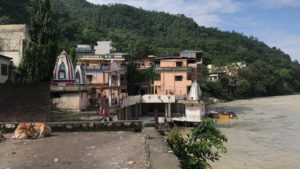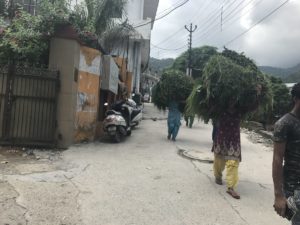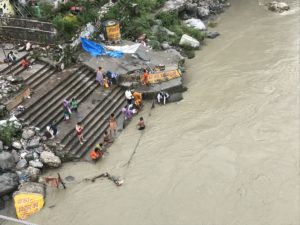
By Isabella Kazanecki, 08/17/2017. So our last stop of the trip was in Rishikesh. I had wanted to go because of a recommendation to speak to Swami Shivanandji at Matri Sadan Ashram a bit on the outskirts of Haridwar, the next city over from Rishikesh, along the Ganga and also a holy city for pilgrimages. I became interested in this ashram because of their devotion to justice for the Ganga. Most religious devotees do not acknowledge the polluted state of the river because this contradicts its ancient identity of purity and strength. This is a really interesting intersection. When does religion come to terms with politics and science? This is one of these times. Matri Sadan has remained devoted to their practice of worshiping Ganga but at the same time works tirelessly to save her physical health.
I had the chance to venture out and speak with Swami Shivanandji after a nail biting thirty minute bus ride on which my friend and I were the only females, and a chaotic rickshaw ride–mind rickshaw not autorickshaw, this was the first time we had been carried such a long distance solely by manpower aka man on a bicycle and I held my breath the whole time, feeling heavier than ever–followed by walking a dirt path into a field. We spoke of many things: history, religion, veganism, political corruption, and our thoughts of universal balance. One thing among many that I found interesting was a form of protest that the men at Matri Sadan take part in in their struggle against pollution of the Ganga. It is called tapas and it is a historically religious practice to purify the body by means of fasting but has been turned into a political act somewhat resembling a hunger strike. I was fascinated to hear about this practice because it manifested to me as a way to really put one’s body on the line and make a statement about the separation of humans and nature. It is an extremely powerful act and I was deeply moved to hear this especially when I learned that a man of the ashram had recently died in the process, allegedly poisoned by a state official when in the hospital after fasting for an extended period. The participation in this collective protest reads as a way to reclaim bodies, a site of collateral damage as the Ganga remains disrespected as–in the words of Katy Dammers– politicized vehicles of action.

Swami Shivanandji also reminded me of the root of the word Ganga meaning to flow continuously, which is why he sees hydropower projects–or more specifically dams– as the biggest threat to the Ganga. He spoke of the ability of Ganga to always flow as her immune system. So the question is, how can Ganga deal with all of this pollution if we are also killing her immune system. We have locked this river into an inevitable fate and our destruction only produces even more destruction. I had met a man in Nepal who worked on hydropower projects and he informed me that during dry season, regulations dictate at least 10% of water must remain in the water and in others, industries can drain as much as they please. This is an astonishing number and it is no wonder dams completely disrupt ecological flow and disable a river to maintain balance. My main concern for the majority of this trip has been sewage management but Swami was not even concerned. There is a legislation right now that has been stayed by supreme court after being passed by the Uttarakhand high court, granting the Ganga human rights and naming it a living entity, as it has been regarded in spiritual communities–it being hard to find a secular community in India this is the overwhelming majority–for centuries. I asked what it would mean for this legislation to pass and what would be the first actions to take place. Swami replied that the dams must be taken away and no new ones can be built. I asked if there would be new sewage treatment centers and he disregarded this responding only that the dams must be taken away. This really helped me understand another intersection of Matri Sadan’s religious devotion and activism as well as the importance of an immune system to a river.

I remember learning this year at the Hudson River Project in New York that the if you dropped an orange into the river it would be in the middle of the Atlantic Ocean in just three days. I thought about how this fact was spoken of as integral in the restoration of the Hudson River in efforts to clean it after the Clean Water Act. I also started paying attention to the contrast of the the Ganga passing through Rishikesh as opposed to the Ganga when I viewed it from Varanasi. Varanasi is farther down the river than Rishikesh and therefore by the time the water has gone through Kanpur, where it takes on a BOD load of 634,915 kg/day. The Kanpur-Varanasi is known as “where Ganga dies many deaths.” For example during this stretch, 3,000 MLD of domestic wastewater is discharged into the river. I can’t help but now think that this could be why the river at Varanasi was awfully still, stagnant, and placid. Whereas, when I was standing on Laxman Jhula looking down at the river below me, I felt like it could have swallowed me up even at my distance. There, the water was fast moving and lively; this is due to a slew of reasons the most obvious being that Rishikesh is closer to the source, Gangotri, than Varanasi is. Despite this, I couldn’t help but notice that there was less activity along the river here. The city is raised and there is no clear way to walk along the river therefore the city’s structure doesn’t really allow for consistent interaction aside from nightly poojas which are without doubt serious events and the sparse ghats. But while it was clear that the Ganga played an important role in the lives of the locals, it didn’t seem to be the central and driving force that it was in Varanasi. While the water in Varanasi was less alive biologically, the human activity in relation to it created more energy than the dams that stifled it.
